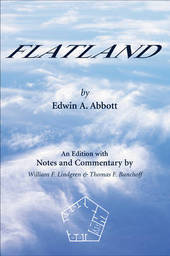
|
Flatland: An Edition with Notes and Commentary
Hardback
Main Details
| Title |
Flatland: An Edition with Notes and Commentary
|
| Authors and Contributors |
By (author) Edwin A. Abbott
|
|
By (author) William F. Lindgren
|
|
By (author) Thomas F. Banchoff
|
| Series | Spectrum |
|---|
| Physical Properties |
| Format:Hardback | | Pages:304 | | Dimensions(mm): Height 235,Width 158 |
|
| Category/Genre | Classic fiction (pre c 1945)
Geometry |
|---|
| ISBN/Barcode |
9780521769884
|
| Classifications | Dewey:530.11 |
|---|
| Audience | | General | | Tertiary Education (US: College) | |
|---|
| Illustrations |
1 Tables, unspecified; 9 Halftones, unspecified; 35 Line drawings, unspecified
|
|
Publishing Details |
| Publisher |
Cambridge University Press
|
| Imprint |
Cambridge University Press
|
| Publication Date |
27 November 2009 |
| Publication Country |
United Kingdom
|
Description
Flatland, Edwin Abbott's story of a two-dimensional universe, as told by one of its inhabitants who is introduced to the mysteries of three-dimensional space, has enjoyed an enduring popularity from the time of its publication in 1884. This fully annotated edition enables the modern-day reader to understand and appreciate the many 'dimensions' of this classic satire. Mathematical notes and illustrations enhance the usefulness of Flatland as an elementary introduction to higher-dimensional geometry. Historical notes show connections to late-Victorian England and to classical Greece. Citations from Abbott's other writings as well as the works of Plato and Aristotle serve to interpret the text. Commentary on language and literary style includes numerous definitions of obscure words. An appendix gives a comprehensive account of the life and work of Flatland's remarkable author.
Author Biography
William F. Lindgren is a Professor of Mathematics at Slippery Rock University. He is the author of Quasi-Uniform Spaces (1982) with Peter Fletcher and has given many talks about Flatland at various conferences, including the Joint Meetings of the AMS/MAA. Thomas F. Banchoff is a Professor of Mathematics at Brown University. He is the author of Beyond the Third Dimension and Linear Algebra Through Geometry (with John Wermer) and the editor of a reprint of Henry P. Manning's The Fourth Dimension Simply Explained.
Reviews"It is all good fun, and the authors point out much that we readers would probably otherwise miss.... This annotated version of Flatland is clearly designed to be enjoyed by a very wide audience. ... Readers of this edition will become more familiar with Edwin A. Abbott the person. The multitude of notes explaining, among other things, Abbott's wordplay, his grasp of classical Greek culture, and his critical views of Victorian society makes us almost feel like we are having a conversation with him.... I highly recommend this edition. Abbott's story can be enjoyed by those with a taste for any combination of mathematics, linguistics, social commentary, history, philosophy, religion, and faith. Lindgren and Banchoff's notes and commentary deepen the enjoyment of these many dimensions of Abbott's creation." David A. Huckaby, MAA Reviews "There (have been) lots of new editions (of Flatland) and further interpretations of the original. But the book presented here is something totally new. ... The book can be highly recommended, it is a must for all admirers of Flatland." Karin Reich, Zentralblatt MATH "Flatland should be in every mathematics collection, and this is the definitive edition. Outstanding Academic Title." C. A. Gorini, Maharishi University of Management, Choice Magazine "With their informative notes, Banchoff and Lindgren add immeasurably to the text. In addition to explanations of arcane terminology and of the mathematics involved, they provide the background necessary to understand the book in the context of Victorian England. It is a period during which entrenched ideas, both social and scientific, were undergoing dramatic metamorphosis. Banchoff and Lindgren's comments on Abbott and his milieu allow the reader to comprehend this fascinating turning point in history. ... The plethora of fascinating background information and detail will make you appreciate the book at a much deeper level." American Scientist
|